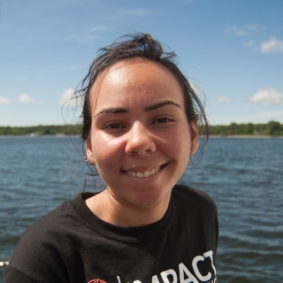Eight students will be presenting the summer work at the Ocean Sciences Meeting in March 2022!
Leysa Lopez, University of Puerto Rico Mayaguez
Class Year:
2017Mentor:
Jeffrey Cornwell, Ph.D. Lorie Staver, Ph.D.Project Title:
Nitrogen Fixation Assessment of the Tidal Marsh Chronosequence at Poplar Island Using Acetylene Reduction Assay
Abstract:
Tidal marshes are among the most productive ecosystems supporting a wide range of biodiversity, but they are being threatened by anthropogenic and natural causes. Restoration projects must be monitored to understand biogeochemical processes and their evolution towards achieving natural functionality. In Poplar Island, where dredge material with a high N pool was used for its construction, N2fixation have not been determined and it will serve as an indicator of marsh chronosequence trajectory toward resembling a natural marsh. The acetylene reduction assay was implemented to measure N2fixation rates in the marsh chronosequence, and to assess the rates in two planting configurations, clumped and dispersed, on two substrates, sand and fine grained dredged material. Preliminary determination of diazotroph organisms was made by adding DCMU to inhibit oxygenic photosynthesis. A positive correlation between N2fixation rates and marsh chronosequence was found. In the planting design study higher fixation was found in sandy sediments and inside plant clumps during the day, demonstrating the substrate characteristics and planting design importance in the development of these projects to achieve proper morphodynamics and biota interactions leading to efficient functionality. N2 fixation after oxygenic inhibitor was added increased relatively rapidly indicating a heterotrophic microbial community presence.
Location:
Horn Point LaboratoryPresentations:
Lopez, L.*, L. Staver, J. Cornwell. 2017. Nitrogen Fixation Assessment of the Restored Tidal Marshes at Poplar Island Using Acetylene Reduction Assay . Coastal Estuarine Research Federation Biennial Meeting, Providence, RI .




